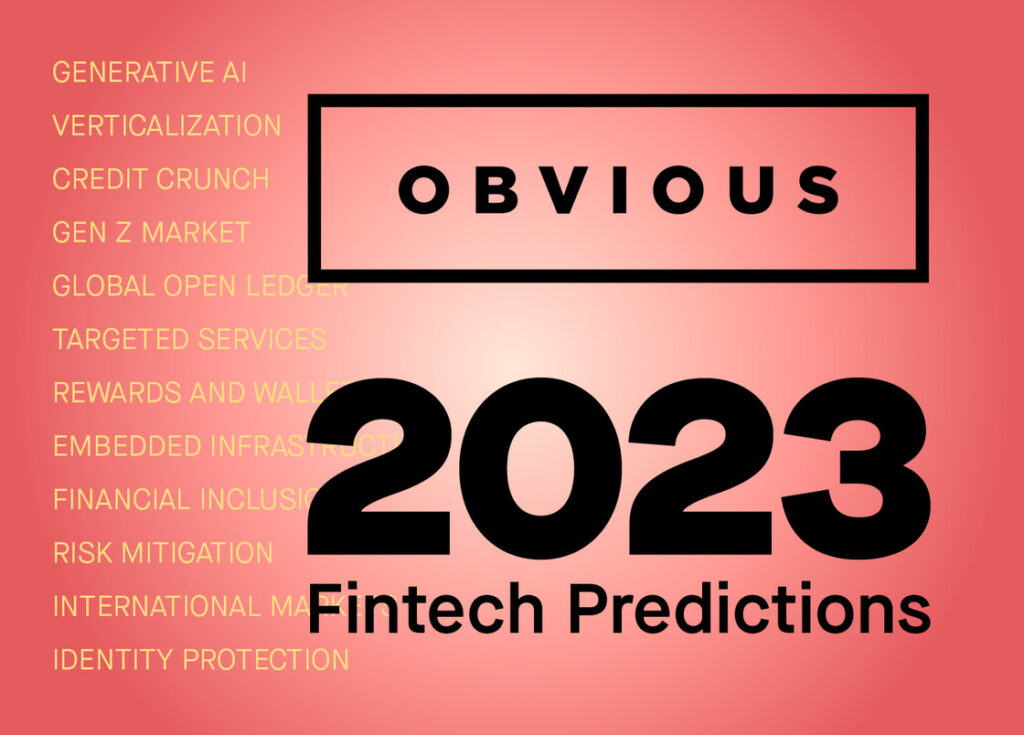22 Fintech Predictions for 2022 and Beyond
Purpose-driven founders are primed to transform our financial systems. Get ready.
Obvious |

It’s no secret that the financial services sector is fraught with problems, despite being so ingrained in our daily lives. Incumbent banks and insurance companies have shockingly low net promoter scores. The mortgage and lending industry do not incorporate the most current understanding of their clients for underwriting purposes. The investment industry has largely focused on making the rich richer. The insurance industry wastes billions on operating costs. The financial industry works as a standalone player versus integrating into the day-to-day life of their customers, often inhibiting them from doing the right things for their customers.
Forever optimists, these challenges also give us a positive outlook on the true potential of financial services. We believe that purpose-driven founders will leverage technology to address these problems and create trillions in new opportunities. As we write this, entrepreneurs are building a more modern financial system to foster accessibility, affordability, transparency, and personalization while delivering incredible customer experiences. In hopes of inspiring the change that we wish to see in the world around us, read on for our predictions of 2022 and beyond.
Banking & Insurance
1. Neobanks and tech-enabled insurance providers will leverage demographic and psychographic segmentation to build brands around the needs of discrete communities (a la USAA). We are starting to see banks for teens, banks for immigrants, insurance for doctors, insurance for retirees, and more.
2. API-driven tools will keep incumbents relevant, particularly small and community banks, and provide their customers with modern digitized services that neobanks benefit from today.
3. Similar to the consumer markets, segmentation will happen in the commercial banking space. Software will fundamentally streamline the internal workings of a company and how a company interacts with the outside world.
4. Despite early insurtech startups’ best efforts to eliminate them, insurance brokers are here to stay. New technology will arise to empower brokers to reach larger audiences, efficiently bind policies, and process claims faster.
5. Emerging threats like cyber-attacks and climate change will escalate the need for these kinds of specialty insurance coverage. New tools and datasets for underwriting across consumers and businesses will scale beyond what is available with traditional insurance providers.
6. The next generation of B2C and B2B technology-based insurance companies will be differentiated by cost-effective distribution, digitized underwriting, and investing in persistent strategies that help bend losses.
7. The modern insurance software stack will be the next category to be unbundled through API-driven headless orientations across payments, underwriting, modern interfaces, risk mitigation, and claims adjustment.
8. We will begin to see a proliferation of embedded financial products across insurance and banking as financial institutions seek to access customers more efficiently and businesses aim to delight their customers.
9. B2B marketplaces will begin to leverage embedded fintech both as a differentiator and as a profit center for high-margin revenue. This will spread across major verticals like healthcare, transportation, and manufacturing.
10. The financial industry’s “hidden monetization methods” (e.g., interchange and lead generation) will come under scrutiny. Full-stack models will realign incentives back with customers, encouraging engagement and responsible capital allocation (e.g., non-partial SaaS-based financial advice or services that improve credit scores).
Payments
11. Driven by digital commerce, diversified payment choices will proliferate to meet unique consumer and business needs. Convenience and cost will drive global adoption in realms like digital wallets, ACH, BNPL, and crypto. Regulators will take a serious look at compliance with new credit options.
Infrastructure
12. Regulatory pushes like open banking and new banking-as-a-service tools will further enable innovation across the financial system. This will allow startups to easily build new types of banking tools and platforms without heavy regulatory and capital requirements.
13. Persistent and integrated data from APIs will transform manual exercises like accounts payable, budgeting, and expense tracking into digitized and connected solutions, building an integrated suite of CFO applications that allow businesses to make better, faster decisions.
14. Real-time data via APIs around income/paycheck, debt, and assets will unlock a more credible cash flow-based underwriting model. This will enable new forms of credit assets for underwriting applications like crypto while rectifying the systemic bias with overlooked customers (i.e: immigrants, freelancers, low-income demographics, etc.).
15. Automated underwriting for loans and insurance will augment human underwriters and improve their productivity. In some cases, human underwriting may end up not being necessary at all.
16. The consumerization of fintech will further infiltrate the B2B market. Features like no-code/low-code, multiplayer collaboration, and gamification will help make financial services more accessible and build competitive moats around acquiring and retaining customers.
Wealth Management
17. Financial wellness will arise as a new employee benefit and an additional way to retain talent. Access to benefits like financial advice, lending, and retirement/insurance plans will be made widely available.
18. Democratization of tools like digital communities, education from experts, and accessibility of financial instruments will empower anyone to become an investor. The next generation of hedge fund and real estate investors may come through these tech-enabled platforms.
19. Specialized financial products like sophisticated hedge fund plays, options strategies, and debt instruments will be made available to the masses. Main street investors will gain access to Wall Street strategies in productized tools.
Blockchain
20. Opportunities to use blockchain technology will accelerate, becoming a tool for new businesses models across businesses and sectors. The emergence of decentralized finance (DeFi) will accelerate the adoption of digital currencies and infrastructure.
21. The financial system will see broad disintermediation as the use cases for DeFi and DAOs become realized, removing misaligned middlemen from the equation. DeFi will reduce the cost of transactions, DAOs will align community incentives, and NFTs will create digital and physical proofs of ownership.
22. We may see a crypto winter as significant regulatory changes will arise, hurting speculators and creating cash crunches for businesses holding significant amounts of cryptocurrencies. In the long term, these regulations will help normalize blockchain services and enable broader adoption.
We’ve been fortunate to partner with digital banks empowering everyday Americans like One, insurance companies delivering outstanding experiences like Corvus, Openly, and Hedvig, benefits managers that power small businesses like Gusto, and a stock exchange revolutionizing mission alignment with shareholders in LTSE. We recognize that we’re only scratching the surface.
If you’re working on a startup in this space, we’d love to hear from you. Reach out at chris@obviousventures.com or vishal@obviousventures.com.



